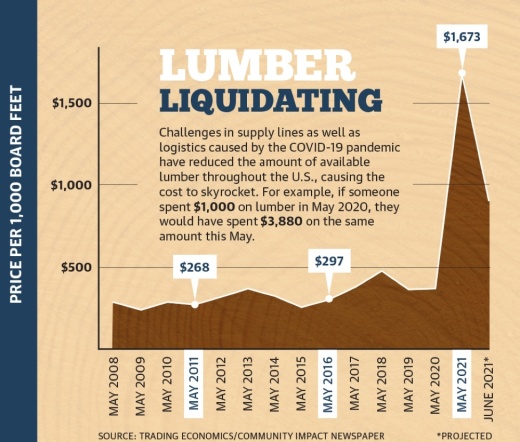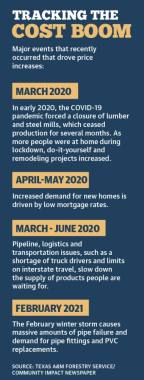Lumber and other building material shortages can be traced to the COVID-19 pandemic, when mills and other production facilities were limited by closures and the number of people allowed in a facility at a given time, according to the National Association of Home Builders.
Increasing costs of materials have added an extra $36,000 to the average cost of building a single-family home and $13,000 to the price of a multifamily home since April 2020, according to data from the NAHB. As building becomes less affordable, new construction of homes has dropped almost 10% in that time.
Additional delays were caused by a reduction in the number of truck drivers and other logistic challenges, according to a study from the Texas A&M Forest Service.
Local officials, builders and other stakeholders from Round Rock to Hutto say they are feeling the effects of this trend.
“We’ve got this real volatility in lumber and concrete, which are like a hurricane, and you’ve got these big waves on the surface, chopping everything up,” said Keith Billington, a new home adviser with Silverton Custom Homes, an Austin-based builder that constructs homes in the Round Rock area. “But what you don’t see is that [the] tide of the ocean underneath just continues to rise, and it keeps rising.”
Skyrocketing costs
Throughout the home builder industry, NAHB data shows serious shortages have been noted in appliances; lumber; windows; doors; plywood; and oriented strand board, which is similar to particle board.
The cost of lumber by board feet, which is 1 square foot and 1 inch thick, has increased by 388% according to Trading Economics, an online economic data platform that provides historical data and forecasts. The cost of 1,000 board feet of lumber increased from $365 in May 2020 to $1,673 this May.
Billington said his company had never seen this kind of volatility in the cost of building materials during the company’s 30-year history.
He added the company has not had to delay projects specifically due to the unavailability of lumber, but it has had to adjust the contract price for homes due to the rapid change in cost of materials. Lumber is not the only type of building supply that is scarcely available, he said.
“It’s across the board—appliances, HVAC, everything is on [backorder],” Billington said.
Varying Vulnerabilities
Another homebuilder that works in the area, Verde Builders Custom Homes, has not experienced difficulties with material unavailability. President Daniel Reeves told Community Impact Newspaper his business model is not as exposed to volatility as some others because the company builds specialty homes.
“Obviously, we have to adjust our budgets, but the key for builders is to communicate with their clients and add an adequate contingency for these cost increases,” Reeves said.
While home construction may not be impacted as strongly, aside from an increase in costs, local officials have stated public construction projects have been heavily impacted due to inflexible funding.
This is because public projects are funded through tax dollars. Round Rock Parks and Recreation Department Director Rick Atkins said his department’s projects already have a set amount of funding through official processes.
Round Rock Park Development Director Katie Baker said the development of projects that started before the shortage and price hike are continuing as planned. That includes Heritage Trail West, which began in January, prior to the onset of the price hikes.
However, Heritage Trail East, which is still in the planning stages, may have to be reduced in size and interpretation due to increasing costs of supplies.
“Really, what it boils down to is, you know, prices have just skyrocketed,” Atkins said. “So that means either you put more money in the project, or you reduce the scope of the project.”
The buying power of smaller organizations such as small businesses and municipalities makes dealing with large changes in price difficult to work around, Atkins said.
“Those entities that have the resources get to do what they want, how they want, [and] typically can absorb those higher prices because they have the ability to make the adjustments,” Atkins said.
Material unavailability
Robert Polanco, a building official with the city of Pflugerville, said his office is not hearing from local developers that construction costs are impacting their schedules.
What is affecting their construction schedules, for the most part, is product availability.
“Products ranging from windows to electrical breakers and panels to appliances have caused delays, since the installation of some of these products are necessary for specific inspections while constructing,” he said.
Beyond those specific hurdles, the city had a record-breaking May with 208 single-family residential permits issued, he said, and added that commercial construction has also continued to increase.
Round Rock Chamber CEO Jason Ball said he has not heard that projects in the area have been canceled due to material availability, but that delays are happening.
“The interesting thing is even at the height of all this, the Austin metro was just trucking [along]; it just never slowed down,” Ball said. “And so we had hits in many sectors of the economy, and those were really painful and continue to have some fallout.”
Though an overarching view of development projects throughout the Austin area may show an adaptive building industry, material shortages are still being felt in many places throughout Central Texas.
Bob Farley, Hutto Economic Development Corp. director, said the lingering impact of COVID-19 on supply chains is something he has seen local businesses working through by delaying completion.
"Unfortunately, you have to pay whatever the market says the value is at that time,” Farley said. “So some people slow down their build process a little bit in order to kind of let materials catch back up ... with market conditions. I don’t see it as being a permanent situation. It’s just one of those things that happens at the end of a major disruptive event like we’ve been through.”







